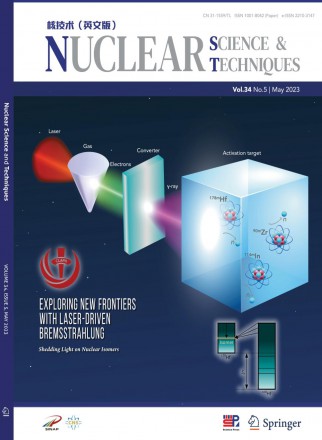
《Nuclear Science and Techniques期刊》CSCD期刊 統計源期刊 SCI期刊
Nuclear Science and Techniques《Nuclear Science and Techniques》雜志是CSCD期刊統計源期刊、SCI期刊、,創辦于1990年,發行周期是雙月刊。綜合影響因子0.09,中國核學會;中國科學院上海原子核研究所主辦,中國科學院主管。主要欄目有同步輻射技術及應用、低能加速器技術、射線技術及應用、核化學、放射化學、放射性藥物和核醫學、核電子學與儀器、核物理與交叉學科研究、核能科學與工程等。
-
主管單位:中國科學院
-
ISSN:1001-8042
-
主辦單位:中國核學會;中國科學院上海原子核研究所
-
CN:31-1559/TL
-
審核時間:1-3個月
-
創刊時間:1990
-
全年訂價: ¥ 672.00
-
發行周期:雙月刊
雜志簡介
《Nuclear Science and Techniques》創刊于1989年,郵發代碼:4-647,由中國科學院上海應用物理研究所;中國核學會主辦。上海市核學會協辦都的綜合性學術期刊。
《Nuclear Science and Techniques》旨在通過介紹國內外最新核科技成果,反映當前中國核科學技術發展的動向和學術水平。主要方向為同步輻射技術及應用、低能加速器技術、射線技術及應用、核化學、放射化學、放射性藥物和核醫學、核電子學與儀器、核物理與交叉學科研究、核能科學與工程等。本刊被SCI-E、CA、SA、CSCD等數據庫收錄。
《Nuclear Science and Techniques》是中國核學會會刊,由國內外核研究領域的著名科學家組成編委會。它刊登理論、實驗和應用核物理,放射化學和輻射化學,核測量方法和儀器,核能與石材料科學、生命科學、農業、地球和環境科學方面的應用,是中國在核研究領域中唯一的一份英文期刊。發表的論文為國際六大著名檢索期刊中的五個所收錄。
期刊須知
1.Title: Titles should be no more than three typeset lines (generally 135 characters including spaces) and should be comprehensible to a broad scientific audience.
2.Author affiliation: Include department, institution, and complete address, with the ZIP/postal code, for each author. Use superscripts to match authors with institutions.
3.Corresponding author: The name, complete address, telephone number, and e-mail address of the author to whom correspondence and proofs should be sent. E-mail addresses will appear in print and online.
4.Body of the paper, including abstract, keywords, introduction, experimental section, results and discussion, conclusion, acknowledgement and references.
5.Abstract: Provide an abstract of no more than 200 words. Abstracts should provide a succinct, informative summation of the most important results and conclusions.
6.Key words: Keywords are listed below the abstract of the manuscript. At least three keywords are required at submission.
7.Introduction: The Introduction should provide a statement outlining the motivation for the research and should accurately place the investigations in context with previous or current work in the field.
8.Experimental Section: The Experimental Section should provide a clear, unambiguous description of materials, methods, and equipment in sufficient detail to permit repetition of the work elsewhere. Repetitive descriptions of a general procedure should be avoided.
9.Results and Discussion: These sections should present the results, and their interpretation, in context with existing knowledge in a clear and concise manner.
10.Conclusion: A conclusion section should be provided in instances where the key elements of the results and discussion may require amplification or clarification. This section should not simply restate the Abstract.
11.Acknowledgments: List acknowledgments.
12.References: References must be in NST style. Only published or in-press papers and books may be cited in the reference list. Unpublished abstracts of papers presented at meetings or references to ‘‘data not shown’’ are not permitted. Each literature reference should be assigned one number and placed in the text as a superscript numeral.
期刊收錄
數據分析
- 綜合影響因子:0.92
- 期刊他引率:暫無
- 被引半衰期:暫無
- 平均引文率:暫無
立即指數
期刊他引率
立即指數:表征期刊即時反應速率的指標,即該期刊在評價當年刊載的論文,每篇被引用的平均次數。
期刊他引率:期刊被他刊引用的次數占該刊總被 引次數的比例用以測度某期刊學術交流的廣度、專業面的寬窄以及學科的交叉程度。
影響因子:指該刊在某年被全部源刊物引證該刊前兩年發表論文的次數,與該刊前兩年所發表的全部源論文數之比。
影響因子
雜志發文量
主要發文機構分析
| 機構名稱 | 發文量 | 主要研究主題 |
| - | - | - |
相關雜志
-
Journal of Thermal Sci...
主管單位:中國科學院
-
Journal of Wuhan Unive...
主管單位:國家教育部
-
Journal of Systems Sci...
主管單位:中國科學技術協會
-
Science China Mathemat...
主管單位:中國科學院
-
Journal of Computer Sc...
主管單位:中國科學院
-
Science China Technolo...
主管單位:中國科學院
-
Science China Earth Sc...
主管單位:中國科學院
-
Journal of Materials S...
主管單位:中國科協
-
Plasma Science and Tec...
主管單位:中國科學院;中國科協
-
Chinese Journal of Pol...
主管單位:中國科學技術協會
-
International Journal ...
主管單位:中華人民共和國教育部
-
International Journal ...
主管單位:中華人民共和國教育部
免責聲明
若用戶需要出版服務,請聯系出版商,地址:上海市800-204信箱 聯合編輯部,郵編:201800。